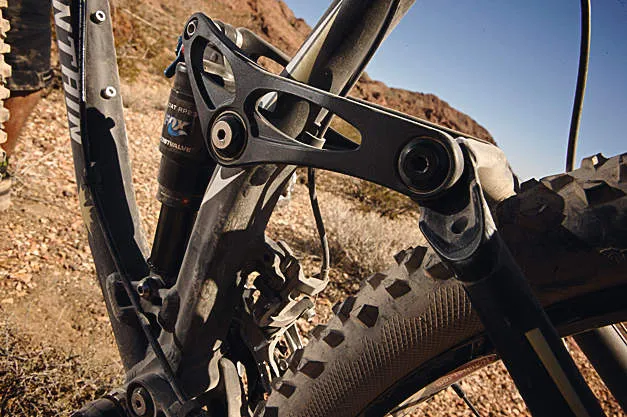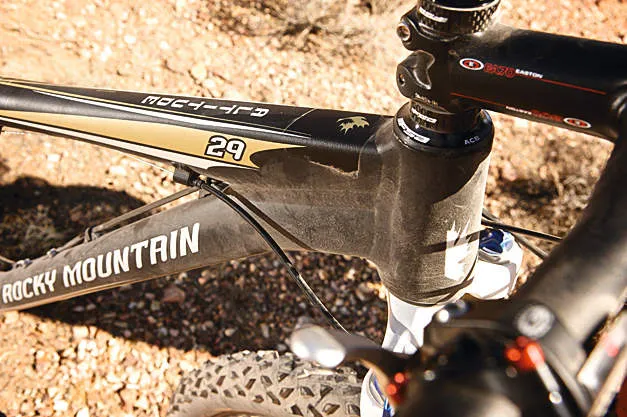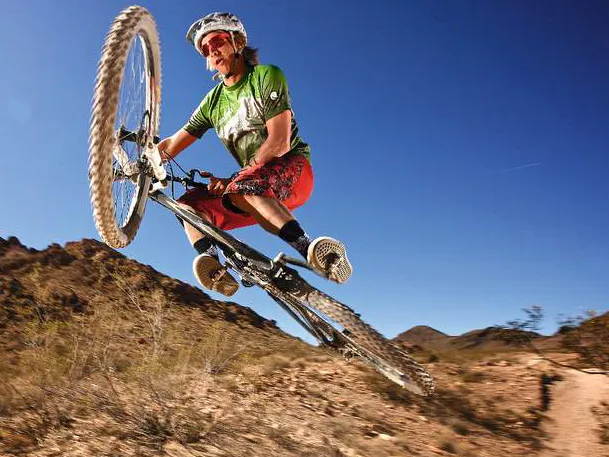RockyMountain have been pushing freeriding and progressive bike limits since the early days of CanadianNorthShore, but they’ve held fire on joining the big wheeler bandwagon until this season. With the new Altitude they’ve hit the target first time round.
Rather than trying to force a big wheeler to do what it naturally won’t, RockyMountain have amplified the high traction, high momentum advantages of the format to the maximum. The Altitude 29 isn't the cheapest, lightest or most agile option but it’s a very assured long distance trail bike and an outstanding technical climber that’s ready to impress 29er cynics and converts alike.
Ride & handling: Big wheels, big travel and definitely big fun
It’s taken a while for the majority of 29ers to feel right, rather than decidedly wonky in the handling department. Despite some radical angles carried over from the 26in bikes it’s obvious very quickly that the Altitude 29 is the right side of the line. Unlike many 29ers the front end is fairly slack and the mid width bar and mid length stem means it sticks to a line resolutely rather than being super-responsive.
The super-steep seat angle puts you in a naturally commanding position over the front of the bike. This encourages you to work the fork into corners and through rock slots, making the most of the screw-through 15mm axle fork. The fact your weight is right forward reduces the chance of twist in the low front end compared to bikes you ride from the back.
The forward weight balance keeps the nose down on steep climbs too, adding to its naturally straight and direct approach to the trail, and the extra traction of the big wheels, to make it an outstanding technical climber. As a result we were grinding our way up serious rocky sections with far more ease than on a conventional 26in wheeled bike despite the relatively high overall weight.
The suspension is very well balanced for pushing the pace and sucking up what you can’t suddenly flick round too. The slight stickiness of the latest generation Fox FIT forks is hidden in the smoother rolling character of the larger wheels. Their excellent damping keeps your rubber on the trail however fast and hectic it gets.
While there’s less travel at the rear than on Rocky Mountain's 26in bikes, the bigger wheels plus pedal-and-brake-neutral four-bar suspension layout maintains excellent connection on technical trails. The custom valved (low velocity, light compression) large chamber Fox Boost Valve shock means this is particularly obvious over square edged bumps both heading up and down the trail, with consistently higher speed retention and traction levels than conventional bikes.

Proof of the overall balance and rideability of the bike was confirmed when we handed it over to hardcore rider and long time 29er sceptic Doddy from Mountain Biking UK magazine. Within a couple of runs he was blasting it out of desert bomb holes several feet up and properly crossed up BMX style. In fact, he liked the bike so much we actually struggled to stop him rock dropping it and railing it round corners long enough to get our own shots.
While it’s got momentum, smooth ground tracking and focused steering on its side on wide open, high speed trails the Altitude 29's bigger wheels do inevitably have some downsides. However light they are in comparative terms, the wheels are harder to accelerate and heave about than 26in hoops. Despite a reasonably short wheelbase this leaves the Altitude feeling hamstrung in tight turn or stop/go situations.
It’s not great on really steep descents either, as without wide bar leverage the front end turns to tuck under once it’s off line or you’re hard on the anchors. 29er spares are a lot easier to come by these days though.
Frame: Stiff and beautifully made
Though it’s theoretically part of the Altitude ‘XC Marathon’ family the Altitude 29 is – as you’d expect – a completely new chassis. Made at Rocky Mountain’s factory in Vancouver, it boasts lovely attention to detail, with cold worked top and down tubes, and a hydroformed seat tube with a large flared rectangular contact for the main pivot and bottom bracket yoke.
To minimise the high lift effect of the bigger wheels the whole frame is kept as low as possible, with a super-short 110mm head tube even on our large sample. A tapered 1.125in top/1.5in bottom head tube and a long shared main tube seam behind it keep as much stiffness in the front end as possible. The 70.5-degree head angle sounds steep in the world of 26in wheels, but on a 29er it makes the bike stable without it being sluggish.
The shallow S-curved down tube uses a squared ‘D’ cross-section to reduce twisting while the tapered top tube is kinked for decent standover clearance. The kinked seat tube design is also carried over from the 26in wheeled Altitude bikes, with a cunning cantilevered tab for the ‘Direct Mount’ front mech. A 76-degree seat angle puts you in a good position for stomping on the pedals and our size large had a 24.3in top tube, which was roomy enough.
The Altitude 29 is limited to 115mm of travel not 140mm on account of the larger wheel size. Twin loop ‘granny's specs’ linkages join seatstay and shock tops via a seat tube piercing rocker pivot. Another pair of forked ‘Clevis’ pivots ahead of the dropouts completes the four-bar linkage suspension system.
Reasonably short 17.8in chainstays adorn the Altitude – it’s easy to lose manoeuvrability and experience increased flex due to longer chainstays on many 29in-wheeled bikes, but not on this one. Remarkably, despite the large volume 2.4in Continental Mountain King tyres, there’s still plenty of mud room and there’s also a conventional bottle cage mount on the down tube.

Equipment: Thoughtful parts spec
RockyMountain have put some thought into speccing the bike too, rather than just templating kit across from their 26in wheeled bikes. Not only does the Altitude 29 get Shimano’s 29er-specific 12-36T rear cassette, but the Race Face big ring is two teeth smaller than usual to reflect the fact it’s churning a bigger wheel round. An Easton flat bar keeps the front end low while stem lengths are size-specific.
Due to the increased circumference, rim and tyre weight is at a premium in terms of responsiveness and overall agility. Props then to RockyMountain for pushing the boat out to fit some of the lightest 29er rims available – Stan’s flat but wide ZTR Flows. They’ve also fitted lightweight but still properly grippy Conti Mountain King tyres, whose shallow contact angle 29er float is amplified even further by the big 2.4in carcass.
Formula’s excellent R1 brakes also get 180mm rotors to handle the increased wheel momentum while keeping weight as low as possible. Shimano no-nonsense XT shifters and Shadow rear mech keep shifting crisp, with upshifts aided by the wheel inertia, while an SLX front changer keeps the chain in check while just avoiding the rear wheel.
Second opinion: Doddy
While hardtail 29ers make sense for their increased rolling speed and grip over rough ground, full-suspension big-wheelers can be ridden much faster – and much harder. Rocky Mountain’s Altitude is a 115mm-travel (4.5in) behemoth that combines great climbing ability with alarming speed on the way back down.
The Altitude doesn’t instantly feel like a 29er – the tight chainstays and fairly normal sized front end feel zippy, and allow quicker acceleration than some bigger wheeled bikes we’ve tried – but you still have to ride it differently to a 26in bike. Where a 26in bike could be compared to a skateboard with a zippy feel, 29ers are more like longboards – they don’t like to be stuffed into turns, they want to carve, but they hold speed like nothing else in their class.
With its supple four-bar rear end, the Altitude really came in to its own through the rough. We were straight-lining rocky uphills, while others were forced to weave and hop. When it came to downhill, we streaked ahead of everyone else in no time at all. There was a little more flex, and it was a little slower through tight stuff, but the Altitude has so much grip, and it really is good fun to ride.


